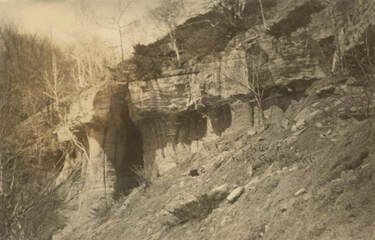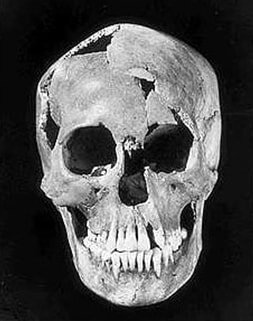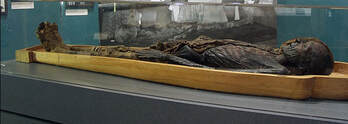Strange Discoveries in Minnesota
 By M.P. Pellicer | Stranger Than Fiction Stories
By M.P. Pellicer | Stranger Than Fiction StoriesIn March, 1921, George Bacon claimed that more than 30 years before he had made a startling discovery deep in a Minnesota cave.
 George Bacon's discovery was retold 30 years later Bacon was a farmer in Fountain, Minnesota, but his discovery took place when he was 11 years old and running in the woods near Preston.
George Bacon's discovery was retold 30 years later Bacon was a farmer in Fountain, Minnesota, but his discovery took place when he was 11 years old and running in the woods near Preston.He'd gone hunting for a wildcat which he though was raiding his farm. The day after he set the trap, he found a trail of blood and fur leading away from the grove near his home.
The family offered a cash reward, and a neighbor boy said he knew where the animal was hiding.
A party of boys and men decided to follow the hunt.
They trekked through 12 miles, and some of the boys who had gone ahead came to the entrance of a great stone archway. It was partially hidden by a tangle of vines.
The entrance was narrow, and they collected $3 from among those who were there, to be given to one boy who could wiggle inside. That boy was George Bacon. After two other boys lost their nerve about entering, he took a lantern with him and cautiously made his way inside. Under a projecting rock there was drop off of about four feet. There he found the dead wildcat.
The boy crawled on for 12 rods and then received a shock which caused him to forget all about the object of his adventure. Against the cave wall lay the body of an elderly woman, enveloped by a long shawl. Her arms were crossed on her bosom. The features were coarse, but quite unlike those of any Indian he had seen.
 Indian cave in Rushford, Minnesota c.1909 She had dark hair, and the feet only had on leather sandals.
Indian cave in Rushford, Minnesota c.1909 She had dark hair, and the feet only had on leather sandals.He crawled back out and told the men gathered what he found. They tried to squeeze in, but the entrance was too narrow. They gave up and returned home. Bacon also returned with the wildcat and the trap. He was given the reward.
Most of those in the town refused to believe George's story, and thought it was a product of a "frightened fancy". All forgot about the adventure except George and his parents. They tried to figure out a way of pulling the body out, but could not come up with a good idea.
George believed there was a fortune to be made if he could "rescue the body", however the years passed, and once he became a man he left Preston. But he never forgot about what he saw in the cave. During a trip home, and after securing legal advice from an attorney who assured him that he had the legal right to attempt recovery of the remains, he returned well equipped to the cave.
Bacon was able to crawl in, but came up against a barrier of rock that had fallen from the roof of the cave. He was afraid of shoveling against it and being buried alive.
Was it a fossil or a mummy? Experts from that time said it was neither. They said it would be impossible for a mummy to stay in an upright position, and that it could not be a petrified body unless there was excessive moisture in the cave. Which might be possible since two boys, who did crawl in as far as the rocks, said the air was very moist and the floor was damp.
Was she an Indian or Caucasian? Was she placed there once dead, or was she entombed alive, and wild beasts had dug away the stone that had been placed to seal her in?
The story revived myths of a civilization preceding the Indians.
 Skull of Minnesota Woman discovered near Pelican Rapids, Minnesota in 1931 In June, 1931, the skeletal remains of a woman were discovered near Pelican Rapids, Minnesota. There was construction being done on U.S. Route 59, and the bones were taken to the University of Minnesota, where Albert Jenks identified it as the skeleton of a teenage woman who had never had children. With her she had a dagger made from an elk's horn and a conch shell pendant. The conch shell came from a species which had only been known to exist in Florida. It was estimated she was 8,000 years old.
Skull of Minnesota Woman discovered near Pelican Rapids, Minnesota in 1931 In June, 1931, the skeletal remains of a woman were discovered near Pelican Rapids, Minnesota. There was construction being done on U.S. Route 59, and the bones were taken to the University of Minnesota, where Albert Jenks identified it as the skeleton of a teenage woman who had never had children. With her she had a dagger made from an elk's horn and a conch shell pendant. The conch shell came from a species which had only been known to exist in Florida. It was estimated she was 8,000 years old.Due to the discovery being made by a road crew, some of the details connected to the girl's death were hard to determine. It appears she was not ritually buried and a thin layers of shells had been placed over the body. It was suspected she might have drowned after falling through ice, or from a boat, and her body covered over in the depths of a glacial lake.
 Digging at location of Minnesota Woman's discovery c.1931 Prior to 1926, the theory was that humans had come to America in the last 2,000 years. The discovery of Minnesota Woman as she was named, disproved this theory, and proved that humans were in Minnesota near the beginning of the Archaic period.
Digging at location of Minnesota Woman's discovery c.1931 Prior to 1926, the theory was that humans had come to America in the last 2,000 years. The discovery of Minnesota Woman as she was named, disproved this theory, and proved that humans were in Minnesota near the beginning of the Archaic period.The remains were reburied on October 2, 1999, by Sioux tribes in South Dakota and further study on them is not available.
Because of its location this was not the same woman that George Bacon saw around 1890, which is about 12 miles from Preston, Minnesota.
 Minnesota's Egyptian mummy In 1925, a donation was made to the Science Museum of Minnesota from the private collection of Mr. and Mrs. Simon P. Crosby.
Minnesota's Egyptian mummy In 1925, a donation was made to the Science Museum of Minnesota from the private collection of Mr. and Mrs. Simon P. Crosby.This was the year it was acquired by the Science Museum lawyer and trustee Simon Crosby while on a Mediterranean trip, which stopped at Cairo. He was accompanied by his wife, daughter, and granddaughter. This was the time of the "Tutmania" craze, which accounts as to why the antiquities dealers Crosby bought it from told him it dated to the 18th dynasty.
In the 1930s, the left half of the head and torso were unwrapped.
It wasn't until the 1960s, that the first x-rays were made, and in 1983, an axial CT scan, endoscopic examination and tissue analysis were completed. It showed all internal organs except the heart had been removed, a common practice done during mummification.
The test supported the museum's theory that the remains belonged to a priest. He had a shaven head, callused feet indicative of someone who walked barefoot, and hands that did not show signs of manual labor. He had good teeth and a light curvature of the spine. He was about 30 to 35 years old
The examination indicated he lived during Egypt's 18th Dynasty when Tutankhamen became pharaoh.
However other facts about the mummy remained a mystery.
It was reexamined in 2016, and it was found it's not as old as originally believed; dating back to the Greco-Roman era (1st century B.C. to 1st century A.D.)
When the mummy lived, Egypt was a Roman province. This was when Cleopatra, Julius Caesar and Caesar Augustus exerted their rule.
Source - The Miami Herald
Published on December 12, 2022 08:00
No comments have been added yet.



